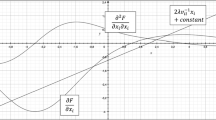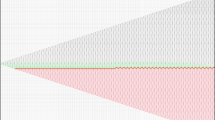Abstract
We evaluate the expected loss and the standard deviation of loss of a bank loan, considering the bank’s strategic control of the expected return on the loan. Assuming that the bank supplies an additional loan to minimize the expected loss of the total loan, we provide analytical formulations for the expected loss and the variance of loss with bivariate normal distribution functions. Using a given expected growth rate and interest rates, two thresholds for the asset/liability ratio can specify three cases. The bank supplies an additional loan to decrease the expected loss in two cases: (i) the asset/liability ratio of the firm is low, and its expected growth rate is high; and (ii) the asset/liability ratio of the firm is high, and the lending interest rate is high. The bank maintains the current loan amount when the asset/liability ratio lies between the two thresholds. Depending on the bank’s strategy, the bank can decrease the initial expected loss of the loan. Conversely, the bank would face a greater risk of the standard deviation of loss.










Similar content being viewed by others
Notes
\((X)^{+}\) denotes the positive part of a real number \(X\), that is, \((X)^{+}=\max (X,0)\). We consider the loss to the bank to include the profit when the firm does not default as a negative loss.
Another way to support the firm in a crisis is lengthening the maturity. However, lengthening the maturity without an additional loan does not improve the firm’s value and the bank’s profitability in this kind of structural model.
The analysis is done on the database by CRD (Credit Risk Database) Association, which can be accessed by contract. http://www.crd-office.net/CRD/english/index.htm.
Most existing studies focused on a collateral value for the loan and assumed that the loss to the bank is the uncovered portion of the debt relative to the collateral (Frye 2000; Pykhtin 2003; Peura and Jokivoulle 2005). On the other hand, Altman et al. (2001) focused on the firm’s asset value in their model and showed that the expected LGD, \(E_0[(D-A_T )^{+}]/D\), is given by \(\varPhi (d_0 )-(A_0 /D)\mathrm {e}^{\mu T}\varPhi (d_0 -\sigma \sqrt{T} )\).
These parameters were determined using Japanese data as follows. \(\mu =1.2\,\%\) is the average growth rate for firms whose stock is listed on the Tokyo Stock Exchange and having an asset/liability ratio of 0–15 %. The average growth rate was forecasted by stock market analysts on July 5, 2013. \(\sigma =3.8\,\%\) is the annualized standard deviation of asset growth rates from March 2000 to March 2013 according to the quarterly data of Financial Statements Statistics of Corporations by Industry published by Ministry of Finance Japan. \(r_{L0}=r_{L}=0.9\,\%\) refer to the average contract interest rates on loans and discounts in May 2013. \(r_{M0}=r_{M}=0.3\,\%\) is the Japanese Bankers Association (JBA) Japanese Yen 6-month Tokyo Interbank Offered Rate (TIBOR) as of July 5, 2013.
The second derivative of EL is evaluated as \(\frac{\partial ^2 EL_t (\varDelta )}{\partial \varDelta ^2}=\frac{(A_t -D\mathrm {e}^{-r_L \tau })^2}{\sigma \sqrt{\tau }(D+\varDelta )(A_t +\varDelta \mathrm {e}^{-r_L \tau })^2}\phi (d_t (\varDelta ))\).
References
Altman, E. I., Resti, A., & Sironi, A. (2001). Analyzing and explaining default recovery rates. London: ISDA Research Report.
Basel Committee on Banking Supervision. (2005). International convergence of capital measurement and capital standards. Basel Committee Publications No. 107.
Drezner, Z. (1978). Computation of the bivariate normal integral. Mathematics of Computation, 32(141), 277–279.
Frye, J. (2000). Collateral damage. Risk, 13(4), 91–94.
Jiménez, G., & Mencía, J. (2009). Modelling the distribution of credit losses with observable and latent factors. Journal of Empirical Finance, 16(2), 235–253.
Kupiec, P. H. (2008). A generalized single common factor model of portfolio credit risk. Journal of Derivatives, 15(3), 25–40.
Merton, R. C. (1974). On the pricing of corporate debt: The risk structure of interest rates. Journal of Finance, 29(2), 449–470.
Moral, G. (2006). EAD estimates for facilities with explicit limits. In B. Engelmann & R. Rauhmeier (Eds.), The Basel II risk parameters (pp. 197–242). Heidelberg: Springer.
Peura, S., & Jokivoulle, E. (2005). LGD in a structural model of default. In E. I. Altman, A. Resti, & A. Sironi (Eds.), Recovery risk. Chap. 11 (pp. 201–216). London: Risk Books.
Pykhtin, M. (2003). Unexpected recovery risk. Risk, 16(8), 74–78.
Yamashita, S., & Yoshiba, T. (2013). Analytical solutions for variance of loss with an additional loan. ISM Research Memorandum No. 1171. http://www.ism.ac.jp/editsec/resmemo/resmemo-file/resm1171. Accessed 05 Mar 2013.
Acknowledgments
The authors would like to thank Professor Masayuki Ikeda (Waseda University) and the participants at the JAFEE-Columbia-ISM joint symposium in Tokyo on March 18–19, 2013 for their useful comments. The authors are also grateful for comments and suggestions on earlier drafts by two anonymous referees. Views expressed in this paper are those of the authors and do not necessarily reflect the official views of the Bank of Japan, which is the second author belongs to.
Author information
Authors and Affiliations
Corresponding author
Appendix: Decision on an Additional Loan at Time \(t\)
Appendix: Decision on an Additional Loan at Time \(t\)
1.1 Critical Value of Asset at Time \(t\)
The first derivative of \(f(d)\) given in Eq. (9) is
where \(\phi (\cdot )\) is the standard normal density. The sign of Eq. (41) is given by
where
Characteristic values of \(f(d)\) are given as
From Eqs. (44)–(46), on the assumption \(f(\bar{d})>0\), there exists \(d_{1}^{*} \) such that \(f(d_1^{*})=0\) for \(d_1^{*}<\bar{d}\) if \(r_L >r_M \), and there exists \(d_2^{*} \) such that \(f(d_2^{*} )=0\) for \(\bar{d}<d_2^{*} \) if \(\mu >r_M\).
Here, we consider the level of asset \(A_t\) at which the bank supplies an additional loan for given values of \(t\), \(T\), \(r_M\), \(r_L\), \(\mu \), and \(\sigma \). We define the function \(h(A_t )\) as
where \(\tilde{d}(A_t)\) is given as Eq. (14). The bank supplies an additional loan if \(h(A_t)<0\). We can confirm that the condition \(h(A_t)<0\) is equivalent to the condition \(\tilde{d}(A_t)<d_1^{*}\) or \(\tilde{d}(A_t)>d_2^{*}\).
If \(\tilde{d}(A_t)<d_1^{*}\), then \(A_t >D\mathrm {e}^{-d_1^{*} \sigma \sqrt{\tau }-(\mu -\sigma ^2/2)\tau }=D\xi _1^{*}\). If \(\tilde{d}(A_t)>d_2^{*}\), then \(A_t<D\mathrm {e}^{-d_2^{*} \sigma \sqrt{\tau }-(\mu -\sigma ^2/2)\tau }=D\xi _2^{*}\). \(D\xi _1^{*}\) and \(D\xi _2^{*}\) are the thresholds of \(A_t\) for which the bank supplies an additional loan.
Now, we derive an optimal additional loan. When \(A_t >D\xi _1^{*}\), then the relation
holds for an additional loan amount \(\varDelta >0\) using \(d_1^{*} <\bar{d}\). It implies that the optimal loan amount \(\varDelta _1^{*}\) satisfies
Similarly, when \(A_t <D\xi _2^{*}\), the following relation holds.
It implies that the optimal loan amount \(\varDelta _2^{*}\) satisfies
From Eqs. (49) and (51), we obtain Eq. (11).
1.2 Parameter Relation for the Optimal Additional Loan
We assume that the firm accepts the additional loan. If the firm maximizes the expected value of the equity after accepting an additional loan \(\varDelta \), this assumption is consistent with the firm’s behavior in the case of \(\mu >r_L\). The expected value of the equity is evaluated as \((A_t +\varDelta \mathrm {e}^{-r_L \tau })\mathrm {e}^{\mu \tau }\varPhi (d_t (\varDelta )-\sigma \sqrt{\tau })-(D+\varDelta )\varPhi (d_t (\varDelta ))\), and the marginal expected value of the equity is given by \(\mathrm {e}^{(\mu -r_L )\tau }\varPhi (d_t (\varDelta )-\sigma \sqrt{\tau })-\varPhi (d_t (\varDelta ))\). If \(\mu >r_L\), the marginal expected value at \(\varDelta =0\), \(\mathrm {e}^{(\mu -r_{L} )\tau }\varPhi (d_t (0)-\sigma \sqrt{\tau })-\varPhi (d_t (0))\), is always nonnegative. It implies that an additional loan increases the expected value of the equity.
The optimal additional loan amount may be infinite if \(r_L >r_M\) and \(\mu >r_M\). If \(r_L \le r_M \) or \(\mu \le r_M \), the amount is always finite. The proof is given in Sect. 1 in this “Appendix”.
These relations are summarized as Table 2.
1.3 Equivalent Condition that the Optimal Additional Loan is Finite
Under the condition \(\partial E_t [L_T (\varDelta )]/\partial \varDelta \vert _{\varDelta =0} <0\), if \(\partial E_t [L_T (\varDelta )]/\partial \varDelta \vert _{\varDelta \rightarrow \infty } <0\) then the optimal additional loan amount is infinite. The second derivative of EL \(\partial ^2 E_t [L_T (\varDelta )]/\partial \varDelta ^2\) is always non-negative,Footnote 6 and the second derivative converges to 0 as \(\varDelta \rightarrow \infty \). It implies that the marginal expected loss converges to a constant as
The necessary and sufficient condition for the optimal additional loan amount to be finite is that the right-hand side of Eq. (52) is positive. It is equivalent to
1.4 Sufficient Parameter Conditions for the Finite Optimal Additional Loan
In this subsection, we prove that the optimal additional loan is finite if \(r_L \le r_M \) or \(\mu \le r_M\). For preparation, we show Proposition 1.
Proposition 1
\(\varPhi (-\alpha +s/2)-\mathrm {e}^{\alpha s}\varPhi (-\alpha -s/2)>0\) for any \(\alpha \in \mathbb {R}\) and \(s>0\).
Proof
Let \(X\) be a random variable distributed as \(\ln X\sim \mathrm {N}(\alpha s-s^2/2,s^2)\). Then,
By definition, \((1-X)^{+}\ge 0\) and, from Eq. (54), the probability that \((1-X)^{+}>0\) is positive. Therefore, \(0<E[(1-X)^{+}]=\int _{-\infty }^{-\alpha +s/2} {(1-\mathrm {e}^{s y+\alpha s-s^2/2})\phi (y)\mathrm {d}y} =\varPhi (-\alpha +s/2)-\mathrm {e}^{\alpha s}\varPhi (-\alpha -s/2)\). \(\square \)
If \(r_L\le r_M\), we can confirm that \(\mathrm {e}^{(r_M -r_L )\tau }-1\ge 0\) and \(\varPhi (\bar{d})-\mathrm {e}^{(\mu -r_L )\tau }\varPhi (\bar{d}-\sigma \sqrt{\tau })>0\) by applying Proposition 1 with \(\alpha =(\mu -r_L)\sqrt{\tau }/\sigma \) and \(s=\sigma \sqrt{\tau }\). This implies that the optimal additional loan is finite if \(r_L \le r_M\).
On the other hand, if \(\mu \le r_M \), then
Using Proposition 1, \(\alpha =(r_L -\mu )\sqrt{\tau }/\sigma \) and \(s=\sigma \sqrt{\tau }\), the right-hand side of Eq. (55) becomes positive. It implies that the optimal additional loan is finite if \(\mu \le r_M\).
Rights and permissions
About this article
Cite this article
Yamashita, S., Yoshiba, T. Analytical Solutions for Expected Loss and Standard Deviation of Loss with an Additional Loan. Asia-Pac Financ Markets 22, 113–132 (2015). https://doi.org/10.1007/s10690-014-9196-5
Published:
Issue Date:
DOI: https://doi.org/10.1007/s10690-014-9196-5




